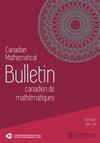大素数因子残馀类中的Benford行为与分布
IF 0.4
4区 数学
Q3 MATHEMATICS
Canadian Mathematical Bulletin-Bulletin Canadien De Mathematiques
Pub Date : 2022-10-10
DOI:10.4153/S0008439522000601
引用次数: 2
摘要
研究了n的第k大素数因子(对于每个固定的$k=1,2,3,\dots $)的前导数分布以及n的所有素数因子的和。在每种情况下,我们发现前导数都是按照Benford定律分布的。此外,在等差数列中,本福德行为与等分布同时出现,且均匀地趋近于小模。本文章由计算机程序翻译,如有差异,请以英文原文为准。
Benford behavior and distribution in residue classes of large prime factors
Abstract We investigate the leading digit distribution of the kth largest prime factor of n (for each fixed
$k=1,2,3,\dots $
) as well as the sum of all prime factors of n. In each case, we find that the leading digits are distributed according to Benford’s law. Moreover, Benford behavior emerges simultaneously with equidistribution in arithmetic progressions uniformly to small moduli.
求助全文
通过发布文献求助,成功后即可免费获取论文全文。
去求助
来源期刊
CiteScore
1.30
自引率
0.00%
发文量
68
审稿时长
24 months
期刊介绍:
The Canadian Mathematical Bulletin was established in 1958 to publish original, high-quality research papers in all branches of mathematics and to accommodate the growing demand for shorter research papers. The Bulletin is a companion publication to the Canadian Journal of Mathematics that publishes longer papers. New research papers are published continuously online and collated into print issues four times each year.
To be submitted to the Bulletin, papers should be at most 18 pages long and may be written in English or in French. Longer papers should be submitted to the Canadian Journal of Mathematics.
Fondé en 1958, le Bulletin canadien de mathématiques (BCM) publie des articles d’avant-garde et de grande qualité dans toutes les branches des mathématiques, de même que pour répondre à la demande croissante d’articles scientifiques plus brefs. Le BCM se veut une publication complémentaire au Journal canadien de mathématiques, qui publie de longs articles. En ligne, il propose constamment de nouveaux articles de recherche, puis les réunit dans des numéros imprimés quatre fois par année.
Les textes présentés au BCM doivent compter au plus 18 pages et être rédigés en anglais ou en français. C’est le Journal canadien de mathématiques qui reçoit les articles plus longs.

 求助内容:
求助内容: 应助结果提醒方式:
应助结果提醒方式:


